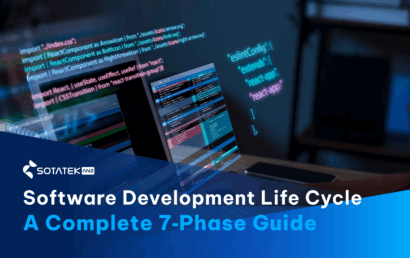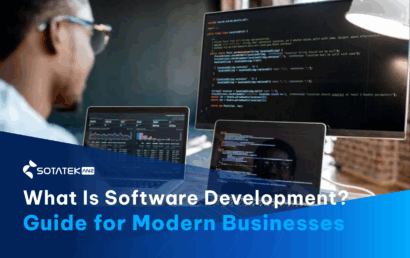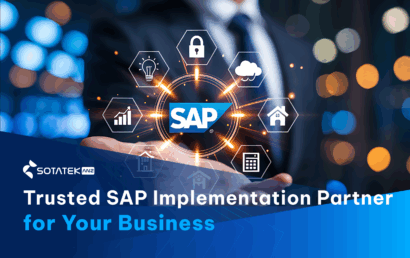Introduction
Across Australia and New Zealand, more companies are realizing the cost of outdated systems and manual processes. While 90% of Australian businesses have initiated some form of digitalization, only 18% have fully transitioned. This gap poses real risks, as competitors with fully integrated systems achieve nearly four times faster ROI and outperform peers by 77%. SAP solutions are increasingly at the core of this shift. In early 2025 alone, SAP’s cloud ERP revenue rose by 34%, reflecting rapid adoption across the region. Australia ERP software market is also projected to reach USD 1.17 billion by 2030.
In this blog, we'll deep dive into "What is SAP", explore key SAP modules, and learn how ANZ businesses can apply SAP solutions to achieve measurable business outcomes. Also, at SotaTek ANZ, we offer a unique combination of strategic understanding, technical depth, and scalable execution to help businesses leverage SAP effectively.
What is SAP?
SAP stands for Systems, Applications, and Products in Data Processing. It is a leading enterprise software platform that integrates diverse business functions, such as finance, human resources, supply chain, sales, and analytics, into a unified system to promote consistency, visibility, and real‑time insights.
By centralizing data and streamlining cross-departmental workflows, SAP enables organizations to break down operational silos, enhance decision-making, and scale more efficiently. The SAP ecosystem comprises hundreds of interconnected modules that cover nearly every business domain, providing enterprises with the flexibility to adopt the capabilities they need.
In short, if you wonder “What is SAP?”, let’s think about it more than just an ERP system. It is the digital backbone that supports modern, data‑driven enterprises.
Key SAP Modules and Use Cases
SAP solutions include multiple specialized modules designed to streamline core business processes. These modules fall under several key categories:

Key SAP Modules
Financial Accounting
- FI/CO (Financial Accounting and Controlling): Manages financial reporting, budgeting, internal cost controls, and accounting transactions.
- RE (Real Estate Management): Supports property and real estate asset management, lease management, and financial integration.
- CS (Customer Service): Facilitates after-sales service processes, warranty management, and customer interaction handling.
Logistics
- MM (Materials Management): Oversees procurement processes, inventory control, and supplier relationships.
- PP (Production Planning): Coordinates manufacturing processes, production scheduling, and resource allocation.
- SD (Sales and Distribution): Manages sales processes, from order handling and delivery logistics to invoicing.
- PM (Plant Maintenance): Supports preventive and corrective maintenance of equipment and facilities to ensure optimal operations.
Human Resources
- HCM (Human Capital Management): Manages employee lifecycle activities, payroll, performance management, and recruitment.
- ESS (Employee Self-Service): Provides employees with tools for personal information management, requests for leave, and benefits.
- MSS (Manager Self-Service): Enables managers to oversee employee-related activities, approvals, performance reviews, and team management.
Cross Application
- CRM (Customer Relationship Management): Manages customer interactions, sales cycles, marketing campaigns, and customer support.
- BW (Business Warehouse): Centralizes data management, analytics, and reporting across all business functions.
- WF (Workflow): Automates business processes, streamlines approvals, task delegation, and integrates workflows across different modules.
Read more: Top 5 Benefits of SAP Development for Businesses in Australia and New Zealand
SAP Deployment: Public, Private, or On-Prem?
Choosing the right SAP deployment model is crucial for businesses across Australia and New Zealand. There are three primary deployment methods, including public cloud, private cloud, and on-premises, and each with distinct advantages:
- Public Cloud: With SAP public cloud deployment, businesses leverage shared cloud infrastructure managed by providers like SAP, AWS, or Microsoft Azure. This model is cost-effective, scalable, and offers rapid deployment and continuous updates, ideal for businesses requiring agility and reduced upfront investment.
- Private Cloud: Private cloud deployment provides dedicated cloud resources hosted either internally or through third-party data centers. It offers enhanced security, customization, and greater control compared to public cloud, suitable for companies with strict compliance requirements or complex infrastructure needs.
- On-Premises: Traditional on-premises deployment involves hosting SAP solutions directly on company-owned servers. While this requires a higher initial investment, it grants complete control over data, infrastructure, and security, making it a preferred choice for highly regulated industries or businesses requiring extensive customization.
For many ANZ businesses, hybrid deployment - combining elements of public and private cloud with existing on-premises systems - can also deliver an optimal balance between flexibility, security, and cost-effectiveness. Ultimately, the choice depends on each company's specific operational requirements, regulatory considerations, and long-term strategic goals.
SAP Implementation Guideline for Australia and New Zealand Businesses
Here are the key steps for successful SAP implementation in Australia and New Zealand:
Step 1: Define Objectives and Scope
Clearly outline your business goals and identify which SAP modules best meet your immediate and future needs.
Step 2: Assess Current Infrastructure
Evaluate existing IT systems, integration capabilities, data quality, and process maturity to determine readiness for SAP.
Step 3: Choose Deployment Model
Carefully select between public cloud, private cloud, on-premises, or hybrid deployments based on your business’s size, compliance requirements, budget, and data security needs.
Step 4: Select a Trusted Implementation Partner
Partner with SAP experts who have strong local market understanding and proven experience in handling regional regulatory and industry-specific requirements.
Step 5: Train Users and Conduct Testing
Invest in comprehensive user training and rigorous system testing (including integration and user acceptance tests) before going live.
Step 6: Post-Implementation Monitoring and Support
Continuously monitor performance, gather user feedback, and optimize the system for sustained operational efficiency.

Steps for SAP Adoption
Special Considerations for Australia and New Zealand Businesses when adopting SAP services:
- Compliance and Data Sovereignty: Be mindful of local compliance standards and regulations, especially concerning data privacy and sovereignty.
- Local Support: Leverage one of the best SAP partners in Australia and New Zealand with experience in navigating the unique market dynamics and regulatory environments, like SotaTek ANZ.
- Scalability and Future-proofing: Plan your implementation to accommodate business growth, technology advancements, and evolving regulatory landscapes in the ANZ region.
Refer to our Whitepaper: Why 2025 is the Tipping Point for SAP Adoption in ANZ for detailed insights into key trends, common challenges, the risks of waiting, and practical next steps to kickstart your SAP journey.
Conclusion
As digital transformation accelerates, adopting SAP solutions is no longer optional. It’s essential for businesses in Australia and New Zealand aiming for competitive advantage and sustained growth. Choosing the right SAP modules, deployment model, and implementation strategy will position your company to thrive in today’s fast-changing business landscape.
With extensive expertise in SAP implementation services in Australia and New Zealand, SotaTek ANZ combines deep strategic understanding, proven technical capability, and reliable local support to deliver successful digital transformations. Partnering with SotaTek ANZ ensures your SAP journey is seamless, impactful, and tailored specifically to the unique requirements of Australian and New Zealand businesses. So, why not contact our SAP experts today?







